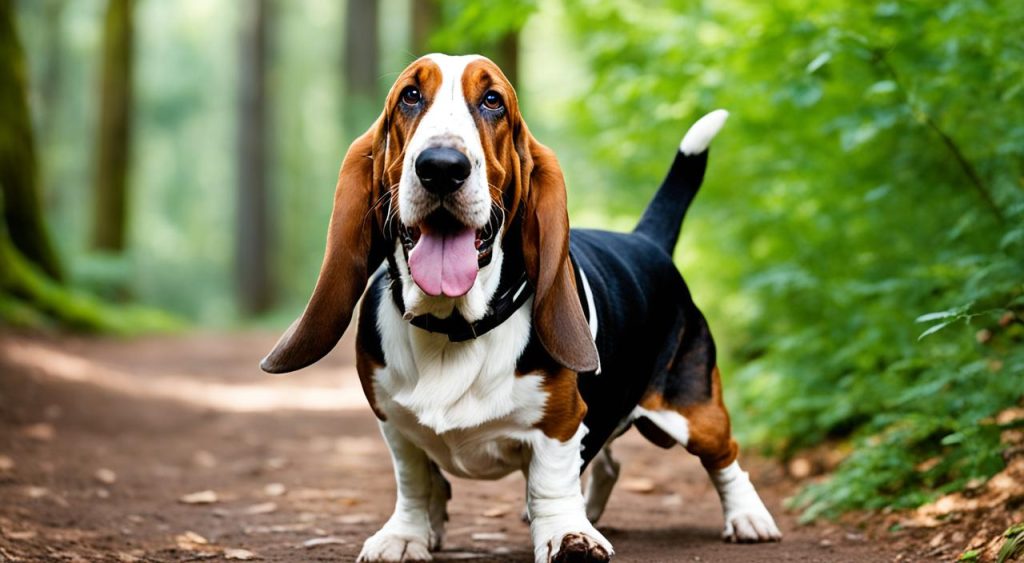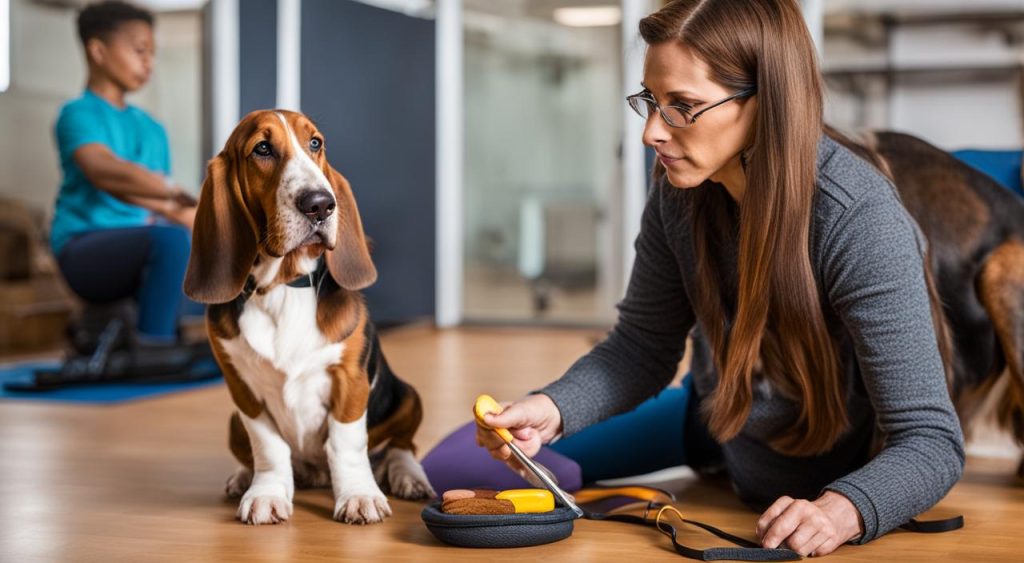When it comes to basset hounds and long walks, there are a few things to consider. Basset hounds are known for their laid-back personalities and low energy levels. While they do enjoy outdoor activities, they are not built for endurance or high-intensity exercises. Taking your basset hound on long walks may not be the best idea if you’re expecting them to keep up with you for extended periods of time.
It’s important to understand and respect the activity level of your basset hound. They are more suited for low-paced exercises and shorter walks that are in line with their natural capabilities. Their short legs and long bodies make them better suited for strolling and sniffing rather than long-distance trekking.
When planning a walk with your basset hound, it’s crucial to take into account their age, health, and nutrition levels. These factors can impact their endurance and overall ability to handle physical activity. Consulting a veterinarian can provide valuable guidance on the appropriate exercise requirements for your basset hound.
Key Takeaways:
- Basset hounds are not built for long walks or high-intensity exercises.
- They are better suited for low-paced activities and shorter walks.
- Consider your basset hound’s age, health, and nutrition levels when determining exercise requirements.
- Consult a veterinarian for personalized guidance on basset hound exercise needs.
- Respect your basset hound’s activity level and adjust walks accordingly.
How far can a basset hound walk?
The walking distance for a basset hound can vary depending on factors such as age, nutrition level, and overall health. It’s important to consider these factors when determining the appropriate exercise routine for your furry friend. As a general guideline, basset hounds can handle two walking sessions of 20-30 minutes per day. Puppies and younger dogs may require shorter walks, while older dogs may need even less exercise.
Listening to your dog’s cues is crucial in determining the appropriate walking distance. If your basset hound seems tired or starts lagging behind, it may be a sign that they’ve had enough exercise for the day. Regular veterinary check-ups can also help determine any specific exercise needs for your individual basset hound.
The pros and cons of walking for basset hounds
Walking is a beneficial activity for basset hounds, providing them with vital physical exercise, mental stimulation, socialization, and behavior management. Regular walks can help reduce bad behaviors and promote overall well-being in these lovable dogs.
One of the key benefits of walking for basset hounds is the opportunity for them to engage in physical exercise. This exercise helps to keep their bodies healthy and fit, preventing weight gain and associated health issues. It also contributes to their overall cardiovascular health, strengthening their heart and lungs.
Walking provides mental stimulation for basset hounds, allowing them to explore their surroundings, enjoy different scents, and interact with their environment. This mental engagement is crucial for their cognitive development and helps prevent boredom, which can lead to destructive behaviors.
Additionally, walking is a great way for basset hounds to socialize with other dogs and humans. It exposes them to different sights, sounds, and smells, helping them become more comfortable and well-adjusted in various social settings. Socialization during walks can improve their behavior and make them more confident and friendly companions.
“Regular walks allow basset hounds to release pent-up energy, leading to a calmer and more balanced temperament.”
However, it’s important to be mindful of the potential risks of overexercising basset hounds. These dogs are prone to joint issues, and excessive walking or high-impact activities can strain their joints and cause long-term damage. In addition, overexertion can lead to exhaustion, stress, and potential health problems. It is crucial to strike a balance between exercise and rest, providing moderate activity that suits the energy levels and capabilities of your basset hound.
By understanding the benefits and risks of walking for basset hounds, you can ensure that this activity enhances their well-being without causing harm. Remember to consult with your veterinarian to determine the appropriate exercise routine for your individual basset hound, taking into consideration their age, health, and specific needs. With proper care and moderation, walking can be a rewarding and enjoyable experience for both you and your furry friend.
Signs of Overworking a Basset Hound
It is important to be aware of the signs that your basset hound may be overexercised or experiencing excessive fatigue during walks. Recognizing these signs early can help prevent further complications and ensure the well-being of your furry friend.
Some common signs of overexercising basset hounds include:
- Excessive panting: If your basset hound is panting heavily and struggling to catch their breath even after a short walk, it may be a sign of overexertion.
- Difficulty breathing: Wheezing, gasping for air, or any other signs of difficulty breathing are red flags that your basset hound may have been pushed too far.
- Excessive drooling: While it’s normal for basset hounds to drool, an excessive amount of drooling during or after exercise can indicate overexertion.
- Difficulty walking or standing: If your basset hound is showing signs of weakness, stiffness, or difficulty walking or standing after a walk, it’s a sign that they may have been overworked.
- Lethargy: Unusual tiredness or lack of energy, even after resting, can be a symptom of excessive exercise.
- Dizziness: If your basset hound appears disoriented, unsteady on their feet, or seems to be losing balance, it may be a sign of overexertion.
It’s important to pay attention to your basset hound’s behavior and body language during and after exercise. If you notice any of these signs, it is crucial to give them a break and consult a veterinarian for proper evaluation and guidance.
Keeping Basset Hounds Safe on Walks
When taking your basset hound for walks, it is important to prioritize their safety. By following a few precautions, you can ensure a pleasant and secure walking experience for both you and your furry friend.
Regular veterinary check-ups are essential to keep your basset hound healthy and fit for exercise. Your veterinarian can provide guidance on the specific needs and limitations of your dog, ensuring their safety during walks.
Before starting a walk, remember to warm up and cool down your basset hound. This helps prevent muscle strains and injuries, especially for older dogs or those with joint issues.
Be aware of the weather conditions before heading out. Extreme temperatures, whether hot or cold, can be harmful to your basset hound. Adjust the duration and intensity of the walk accordingly, or consider alternative activities indoors.
Hydration is crucial during walks. Carry water and a portable bowl for your basset hound to drink from. This will help prevent dehydration, especially on hot days or longer walks.
Always use a leash when walking your basset hound. This ensures their safety and prevents them from running into potentially dangerous situations or getting lost. Choose a leash that is sturdy and appropriate for your dog’s size and strength.
Pay attention to the surfaces you and your basset hound walk on. Be cautious of hazardous areas such as hot pavement, sharp objects, or toxic substances. Avoid walking on surfaces that may cause discomfort or injury to your dog’s sensitive paws.
Observe your basset hound’s body language during the walk. If they show signs of exhaustion or discomfort, take a break or shorten the walk. It is important to listen to their needs and adjust the activity accordingly.
Carry identification for your basset hound, such as a collar with tags or a microchip. This ensures that they can be easily identified and returned to you in case they get lost during a walk.
Stay visible to drivers by using reflective gear or accessories, especially when walking during low-light conditions. This helps ensure that you and your basset hound are visible and safe on the road.
Lastly, be respectful of other animals and humans during your walks. Ensure that your basset hound is properly socialized and well-behaved around other animals and people. Keep them on a leash and under control to prevent any potential incidents.
Consultations with a Veterinarian
When it comes to determining the appropriate exercise level and requirements for your basset hound, consulting a veterinarian is crucial. A vet can provide you with personalized guidance based on your dog’s age, health status, and specific needs. Regular veterinary check-ups are essential to ensure that your dog is healthy and fit for exercise and to identify any underlying conditions that may affect their exercise capacity.
Tips for Exercising Basset Hounds
When it comes to exercising basset hounds, it’s important to keep their unique needs and limitations in mind. Here are some tips to ensure a safe and enjoyable exercise routine for your basset hound:
-
Start Slow: Begin with low-intensity exercises and gradually increase the intensity and duration over time. This allows your basset hound’s body to adjust and prevents strain or injury.
-
Provide Mental Stimulation: Basset hounds are intelligent dogs that benefit from mental stimulation. Incorporate training sessions, puzzle toys, and interactive games into their exercise routine to keep their minds sharp.
-
Listen to Your Dog: Pay attention to your basset hound’s body language and cues during exercise. If they show signs of fatigue, such as heavy panting or slowing down, it’s time to take a break. Understanding their limits is essential to prevent overexertion.
-
Consider Their Activity Recommendations: Basset hounds have specific activity recommendations based on their age, health, and fitness level. Consult with your veterinarian to determine the ideal exercise routine for your basset hound.
-
Choose Low-Impact Exercises: Due to their long bodies and short legs, basset hounds are prone to joint issues. Opt for low-impact exercises like swimming or gentle walks on soft surfaces to minimize stress on their joints.
-
Be Consistent: Regular exercise is crucial for your basset hound’s overall wellbeing. Establish a consistent exercise schedule that fits into both your routine and your basset hound’s needs.
By following these exercise tips and best practices, you can ensure that your basset hound stays fit, happy, and healthy.
Conclusion
While basset hounds may not possess the endurance for long walks, they can still enjoy the benefits of regular exercise through shorter walks, low-paced activities, and mental stimulation. It’s crucial to take into account your basset hound’s age, health, and energy levels when establishing an appropriate exercise routine. Consulting with a veterinarian and ensuring the dog’s well-being during walks is key to maintaining a happy and healthy basset hound.





